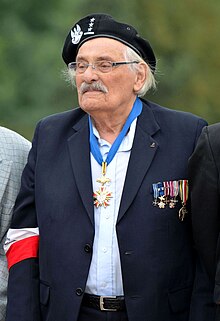Samuel Willenberg
| Samuel Willenberg | |
|---|---|

Samuel Willenberg at Treblinka,
August 2, 2013 |
|
| Born |
February 16, 1923 , Poland |
| Died | February 19, 2016 (aged 93) Udim, Israel |
| Nationality | Polish, Israeli |
| Known for | Holocaust art |
| Movement | Realism, post-expressionism |
Samuel Willenberg, nom de guerre Igo, (February 16, 1923 – February 19, 2016) was a Polish-Jewish prisoner of Treblinka extermination camp who participated in its perilous prisoner revolt. He took part in the Warsaw Uprising before the war's end. Willenberg was the last survivor of the August 1943 Treblinka prisoners’ revolt upon his death. After the war he lived in Israel. He received the highest of Poland's orders including Virtuti Militari and the Commander's Cross of the Order of Merit awarded by President Lech Kaczyński. His memoir, titled Revolt in Treblinka, was published in Hebrew, Polish and English between 1986 and 1991. He was a sculptor and painter.
Samuel Willenberg was born in . His father, Perec Willenberg, was a teacher at a local Jewish school before World War II, a talented painter and visual artist himself, who used to work on assignments decorating synagogues. His mother, Maniefa Popow, was an Polish-Orthodox Christian before converting to Judaism after their wedding. The family lived in Częstochowa before relocating to Warsaw.
In the course of the Nazi German invasion of Poland, on September 6, 1939 Willenberg set off in the direction of Lublin to join the Polish Army as a volunteer. Within days, the Soviets invaded from the east. He was severely wounded on September 25, in a skirmish with the Red Army near Chełm, and captured. Three months later, he escaped from the hospital back to central Poland to reconnect with his family in Radość (now a part of Warsaw). They went to Opatów including his mother and two sisters at the beginning of 1940 to meet his father, who worked there on murals for the synagogue. However, at the same time the Nazis began herding Polish Jews into ghettos all across the country. The Opatów Ghetto (founded in the spring of 1941) although without the fence, quickly became hazardous. The Jews expelled from Silesia were brought in. An epidemic of typhus broke out. Willenberg traded his father's paintings for the necessities of life, but also worked at a steel mill in Starachowice for several months, along with hundreds of forced laborers supplied by the Judenrat.
...
Wikipedia
